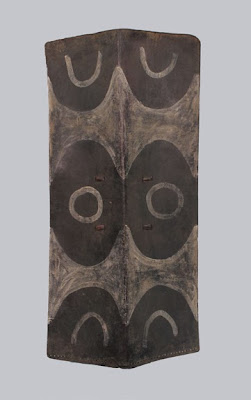 |
|
Shield, early 20th Century
Konyak Naga people; Nagaland, Mayanmar (Burma)
Mithan hide, rattan and paint; 35 1/2 x 16 5/8 x 3 1/2 in.
2011.17.2
Gift of the Orange County Bead Society a Bowers Museum Affiliate Group
|
Shields have been used the world over not only for protection, but also as portable canvases displaying emblems of heraldry, symbols of intimidation or power, or visual affiliation to a specific clan. This 20th century Naga shield in the Bowers’ collection is no different. The Naga are a diverse cultural group residing in the mountainous region on the border of India and Burma; the shield here is from the Konyak Naga, a powerful group of Naga that also control a major trading center. Konyak shields display similar characteristics: rectangular shape, raised central ridge, and use of white geometric designs. These characteristics indicate that the shield design is not only for battle but, a symbol of identity for a Konyak warrior. Pictorial essays of the Konyak Naga in daily life show men presenting their shields, painting designs on the front, and dancing with them during spring festivals. The attention given to shields and objects of warfare demonstrates their important role within warrior society, where before the 20th century, ritual head-hunting and village feuds played a part in traditional Naga life.
Naga shields are usually made of animal hide that is dried in some way. This Konyak shield is made of buffalo (mithun) hide and decorated in white paint, the shield is held by a rattan strap in the back center. The shield is approximately 3 feet in length which would provide coverage for most of the warrior’s body; this size is consistent amongst Konyak shields. Naga shields could be made for combat or for ceremonial purposes and the relatively simple design of this shield suggests it was used for combat. The Naga were also known for their flamboyant and imaginative crafts and in contrast to the basic combat shield Konyak ceremonial shields were lavishly covered with tiger, leopard or bear skins, and decorated with tassels of red and black goat hair. The Naga warrior took pride in displaying emblems of his status as a successful warrior and this shield was undoubtedly a symbol of prestige and source of pride for the owner.
All text and images under copyright. Please contact Collection Department for permission to use. Information subject to change upon further research.


Comments